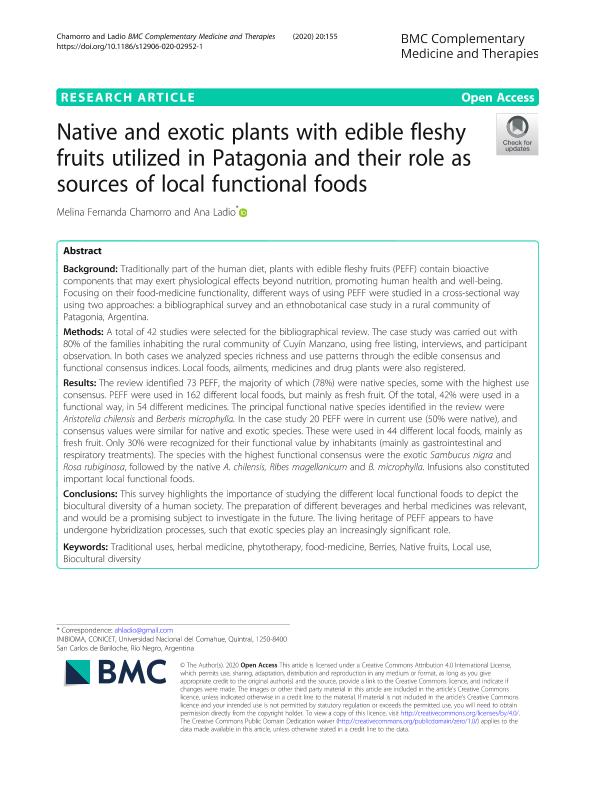Mostrar el registro sencillo del ítem
dc.contributor.author
Chamorro, Melina Fernanda

dc.contributor.author
Ladio, Ana Haydee

dc.date.available
2021-11-25T16:46:33Z
dc.date.issued
2020-05
dc.identifier.citation
Chamorro, Melina Fernanda; Ladio, Ana Haydee; Native and exotic plants with edible fleshy fruits utilized in Patagonia and their role as sources of local functional foods; BioMed Central; BMC Complementary Medicine and Therapies; 20; 5-2020; 1-16
dc.identifier.uri
http://hdl.handle.net/11336/147418
dc.description.abstract
Background: Traditionally part of the human diet, plants with edible fleshy fruits (PEFF) contain bioactive components that may exert physiological effects beyond nutrition, promoting human health and well-being. Focusing on their food-medicine functionality, different ways of using PEFF were studied in a cross-sectional way using two approaches: a bibliographical survey and an ethnobotanical case study in a rural community of Patagonia, Argentina. Methods: A total of 42 studies were selected for the bibliographical review. The case study was carried out with 80% of the families inhabiting the rural community of Cuyín Manzano, using free listing, interviews, and participant observation. In both cases we analyzed species richness and use patterns through the edible consensus and functional consensus indices. Local foods, ailments, medicines and drug plants were also registered. Results: The review identified 73 PEFF, the majority of which (78%) were native species, some with the highest use consensus. PEFF were used in 162 different local foods, but mainly as fresh fruit. Of the total, 42% were used in a functional way, in 54 different medicines. The principal functional native species identified in the review were Aristotelia chilensis and Berberis microphylla. In the case study 20 PEFF were in current use (50% were native), and consensus values were similar for native and exotic species. These were used in 44 different local foods, mainly as fresh fruit. Only 30% were recognized for their functional value by inhabitants (mainly as gastrointestinal and respiratory treatments). The species with the highest functional consensus were the exotic Sambucus nigra and Rosa rubiginosa, followed by the native A. chilensis, Ribes magellanicum and B. microphylla. Infusions also constituted important local functional foods. Conclusions: This survey highlights the importance of studying the different local functional foods to depict the biocultural diversity of a human society. The preparation of different beverages and herbal medicines was relevant, and would be a promising subject to investigate in the future. The living heritage of PEFF appears to have undergone hybridization processes, such that exotic species play an increasingly significant role.
dc.format
application/pdf
dc.language.iso
eng
dc.publisher
BioMed Central

dc.rights
info:eu-repo/semantics/openAccess
dc.rights.uri
https://creativecommons.org/licenses/by/2.5/ar/
dc.subject
BERRIES
dc.subject
BIOCULTURAL DIVERSITY
dc.subject
FOOD-MEDICINE
dc.subject
HERBAL MEDICINE
dc.subject
LOCAL USE
dc.subject
NATIVE FRUITS
dc.subject
PHYTOTHERAPY
dc.subject
TRADITIONAL USES
dc.subject.classification
Otras Ciencias Biológicas

dc.subject.classification
Ciencias Biológicas

dc.subject.classification
CIENCIAS NATURALES Y EXACTAS

dc.title
Native and exotic plants with edible fleshy fruits utilized in Patagonia and their role as sources of local functional foods
dc.type
info:eu-repo/semantics/article
dc.type
info:ar-repo/semantics/artículo
dc.type
info:eu-repo/semantics/publishedVersion
dc.date.updated
2021-01-27T19:54:54Z
dc.identifier.eissn
2662-7671
dc.journal.volume
20
dc.journal.pagination
1-16
dc.journal.pais
Reino Unido

dc.journal.ciudad
Londres
dc.description.fil
Fil: Chamorro, Melina Fernanda. Consejo Nacional de Investigaciones Científicas y Técnicas. Centro Científico Tecnológico Conicet - Patagonia Norte. Instituto de Investigaciones en Biodiversidad y Medioambiente. Universidad Nacional del Comahue. Centro Regional Universidad Bariloche. Instituto de Investigaciones en Biodiversidad y Medioambiente; Argentina
dc.description.fil
Fil: Ladio, Ana Haydee. Consejo Nacional de Investigaciones Científicas y Técnicas. Centro Científico Tecnológico Conicet - Patagonia Norte. Instituto de Investigaciones en Biodiversidad y Medioambiente. Universidad Nacional del Comahue. Centro Regional Universidad Bariloche. Instituto de Investigaciones en Biodiversidad y Medioambiente; Argentina
dc.journal.title
BMC Complementary Medicine and Therapies
dc.relation.alternativeid
info:eu-repo/semantics/altIdentifier/url/https://bmccomplementmedtherapies.biomedcentral.com/articles/10.1186/s12906-020-02952-1
dc.relation.alternativeid
info:eu-repo/semantics/altIdentifier/doi/http://dx.doi.org/10.1186/s12906-020-02952-1
Archivos asociados
